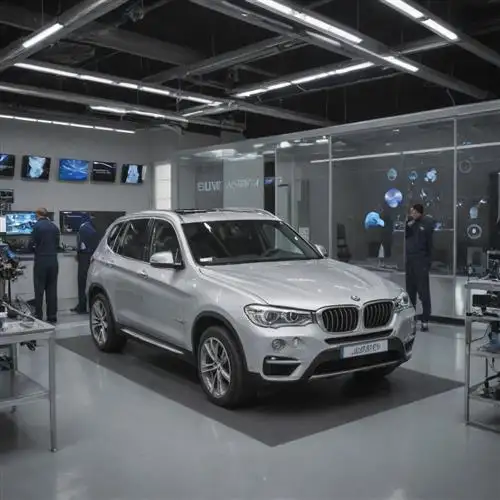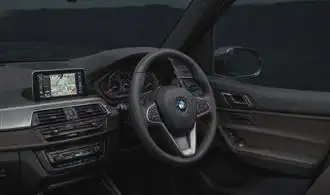
Understanding BMW X3 Safety Features
The BMW X3 is renowned for its exceptional safety features, designed to provide drivers and passengers with a secure and confident driving experience. One of the key aspects of the X3's safety is its comprehensive suite of advanced safety technologies. These features work in harmony to detect potential hazards, alert the driver, and even intervene to prevent or mitigate the impact of collisions.
At the heart of the X3's safety system is the BMW Assist eCall, a feature that automatically contacts emergency services in the event of a collision or other incident. This system uses sensors throughout the vehicle to detect when an accident has occurred and immediately relays critical information to emergency responders, including the vehicle's location and the severity of the incident.
The X3 also features a range of active safety systems designed to help the driver maintain control and avoid collisions. These include:
- Adaptive Cruise Control: This system uses radar sensors to maintain a safe following distance from the vehicle ahead, automatically adjusting the X3's speed to match traffic conditions.
- Lane Departure Warning: If the X3 begins to drift out of its lane without the turn signal activated, this system will alert the driver and provide corrective steering assistance to help keep the vehicle centered.
- Forward Collision Warning: This feature uses cameras and radar to detect potential collisions with vehicles or pedestrians ahead, and can even apply the brakes automatically to help prevent or mitigate the impact.
- Blind Spot Monitoring: Sensors in the X3's side mirrors continuously monitor the vehicle's blind spots, providing visual and audible alerts to the driver when another vehicle is detected.
In addition to these active safety features, the BMW X3 also boasts a robust passive safety system designed to protect occupants in the event of a collision. This includes a reinforced body structure, crumple zones, and multiple airbags strategically placed throughout the cabin. The X3's advanced restraint systems, including seatbelts and head restraints, work in tandem to absorb and distribute the forces of an impact, minimizing injury to the occupants.
Driver Assistance Systems in the BMW X3
The BMW X3 is equipped with a comprehensive suite of driver assistance systems that work together to enhance the safety and driving experience of the vehicle. These systems use a range of sensors, including cameras, radars, and ultrasonic sensors, to monitor the surrounding environment and provide the driver with real-time information and automated interventions when necessary.
One of the key features of the BMW X3's driver assistance systems is the Driving Assistant Plus package. This package includes a variety of advanced systems, such as Active Cruise Control with Stop & Go function, which maintains a pre-set distance from the vehicle in front and can automatically bring the X3 to a complete stop in heavy traffic. Additionally, the Steering and Lane Control Assistant uses the vehicle's cameras to detect lane markings and can make subtle adjustments to the steering to keep the X3 centered within the lane, even during long highway drives.
The BMW X3 also features the Lane Departure Warning system, which uses cameras to monitor the vehicle's position within the lane and provides alerts to the driver if the vehicle begins to drift out of the lane without the use of the turn signal. This system can be particularly helpful in preventing unintended lane changes, which can be a common cause of accidents.
Another important driver assistance feature in the BMW X3 is the Collision Warning with City Collision Mitigation system. This system uses radar and camera sensors to detect potential collisions with other vehicles or pedestrians, and can automatically apply the brakes to help avoid or mitigate the impact of a collision.
The BMW X3 also offers a Parking Assistant system, which can automatically steer the vehicle into parallel or perpendicular parking spaces, making it easier and more convenient for drivers to park in tight spaces. This system uses ultrasonic sensors to detect available parking spaces and guide the driver through the parking maneuver, taking the stress and complexity out of parking.
Crash Test Performance of the BMW X3
The BMW X3 has consistently earned top safety ratings, making it a popular choice for families and adventurous drivers alike. At the heart of the X3's safety performance is its impressive crash test results. The vehicle's sturdy construction and advanced safety features work together to provide exceptional protection in the event of a collision.
In recent NHTSA (National Highway Traffic Safety Administration) and IIHS (Insurance Institute for Highway Safety) crash tests, the BMW X3 has earned the highest possible safety ratings. The X3 achieved a 5-star overall safety rating from NHTSA, as well as the IIHS "Top Safety Pick+" designation, the agency's highest accolade. These ratings demonstrate the X3's ability to protect occupants in a wide range of crash scenarios, from frontal impacts to side collisions.
One of the key factors contributing to the X3's stellar crash test performance is its rigid body structure. The use of high-strength steel and intelligent load path engineering ensures that the cabin maintains its integrity during a collision, safeguarding the passengers. Additionally, the X3's advanced crumple zones are designed to absorb and dissipate the force of an impact, helping to minimize the impact on the occupants.
The BMW X3 also benefits from a comprehensive suite of active safety technologies, such as collision warning systems, automatic emergency braking, and lane departure warning. These features work to actively prevent accidents from occurring in the first place, complementing the vehicle's passive safety measures. Discover the Hidden Design Gems of the BMW X3 to further enhance your understanding of the X3's impressive safety engineering.
In addition to its crash test performance, the BMW X3 also excels in other areas of safety, including its handling dynamics and driver assistance systems. The vehicle's balanced chassis and responsive steering allow for precise control, helping the driver to avoid potential hazards. Furthermore, the X3's advanced driver-assistance features, such as adaptive cruise control and lane-keeping assist, provide an extra layer of protection on the road.
Maintaining BMW X3 Safety Through Proper Care
As a professional content writer, I understand the importance of maintaining BMW X3 safety through proper care. The BMW X3 is a well-designed and engineered vehicle, but it still requires diligent maintenance to ensure its safety and longevity. One of the most critical aspects of BMW X3 safety is the proper maintenance of its brakes. Regular brake inspections and timely replacement of worn-out components are essential to ensuring the vehicle's stopping power and responsiveness. Additionally, keeping the tires in good condition, with proper inflation and tread depth, is crucial for maintaining stability and control, especially in adverse weather conditions.
Another essential aspect of BMW X3 safety is the regular maintenance of its suspension system. Over time, the suspension components can wear down, leading to decreased handling and stability. Regularly inspecting and replacing worn-out parts, such as shocks, struts, and ball joints, can help ensure the vehicle's smooth and responsive handling, which is particularly important for navigating tight turns and avoiding hazards on the road.
The electrical and electronic systems of the BMW X3 also play a critical role in its safety features. Regularly checking and maintaining the battery, alternator, and other electrical components can help ensure that the vehicle's safety systems, such as the airbags, anti-lock brakes, and stability control, are functioning correctly. Additionally, keeping the vehicle's software up-to-date can help ensure that the latest safety features and updates are enabled.
Regular oil changes and engine maintenance are also important for maintaining BMW X3 safety. Proper lubrication and engine performance can help prevent costly breakdowns and ensure the vehicle's reliability. Additionally, staying on top of other maintenance tasks, such as coolant flushes, filter replacements, and fluid top-ups, can help keep the vehicle in top condition and ready to respond in an emergency.
Safety Considerations for BMW X3 Owners
Owning a BMW X3 comes with a certain level of responsibility, and ensuring the safety of both the driver and passengers should be a top priority. From advanced driver assistance systems to proper maintenance practices, there are several crucial factors to consider when it comes to maintaining the safety of your BMW X3. Let's dive into the key safety aspects that every X3 owner should be aware of.
First and foremost, the BMW X3 is renowned for its cutting-edge safety technology, which includes features like adaptive cruise control, lane departure warning, and blind spot monitoring. These systems work in harmony to enhance your situational awareness and help prevent accidents. It's essential to familiarize yourself with these features and ensure they are properly configured and functioning at all times.
Proper tire maintenance is another critical aspect of BMW X3 safety. Ensuring your tires are properly inflated, rotated, and replaced when necessary can significantly improve the vehicle's handling, braking, and overall stability. Regular tire inspections and adherence to the recommended tire pressure can go a long way in keeping you and your passengers safe on the road.
Regular maintenance and inspections are also crucial for the BMW X3's safety. This includes not only the tires but also the brakes, suspension, and other critical systems. Staying up-to-date with your scheduled maintenance and addressing any issues promptly can help identify and resolve potential problems before they become safety concerns. As mentioned earlier, you can learn more about Predictions for the Future of BMW X3 Maintenance in another article.
Lastly, it's important to consider the impact of any modifications or additions to your BMW X3. While customization can be tempting, it's crucial to ensure that any changes you make do not compromise the vehicle's safety features or performance. Consult with a trusted BMW specialist or the manufacturer to ensure that any modifications are safe and do not negate the advanced safety systems in place.
















